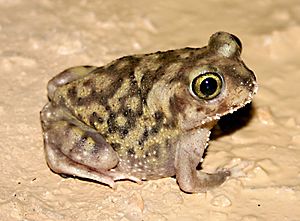Couch's spadefoot toad facts for kids
Quick facts for kids Couch's spadefoot toad |
|
|---|---|
 |
|
| Conservation status | |
| Scientific classification |
The Couch's spadefoot toad (Scaphiopus couchii) is a special type of North American spadefoot toad. It was named after an American naturalist, Darius Nash Couch. He was the first person to collect a specimen of this toad during a trip to northern Mexico. He collected plants, minerals, and animals for the Smithsonian Institution.
About Couch's Spadefoot Toads
Unlike most other toads, spadefoot toads have pupils that are shaped like a vertical line, not horizontal.
These toads get their name from a hard, dark "spade" found on the underside of their back feet. This "spade" helps them dig into the ground. They use it to bury themselves to stay safe from predators and to keep from losing water.
Couch's spadefoot toads can grow up to about 3.5 inches long. There are two types of spadefoot toads in the Sonoran Desert. The Couch's spadefoot toad has a spade shaped like a sickle. The western spadefoot toad has a rounded spade. It's important to remember that spadefoots are not "true toads." So, it's best to just call them spadefoots!
Where They Live
Couch's spadefoot toads live in the southwestern United States. You can find them in places like southeastern Colorado and central Oklahoma. They also live in northern Mexico and the Baja peninsula.
They are common throughout the Sonoran Desert. This desert covers parts of southern Arizona and California.
Reproduction and Life Cycle
Water is super important for spadefoot toads to have babies. The eggs need water to be fertilized. Once the eggs hatch, the baby toads, called tadpoles, need water to grow into adults.
Because water is so vital, spadefoots are active during the wet season. This is usually spring and summer in the Northern Hemisphere. During the dry season (fall and winter), they stay buried underground.
When a summer thunderstorm starts, male toads come out from underground. They look for pools of rainwater. Once they find water, the males make a special mating call to attract female toads. Recent studies show that female toads like brighter colored males more than darker ones. This helps them pick the best mates. Since rain pools might not last long, mating happens on the very first night after the rain begins.
During mating, the male gets on the female's back. He releases sperm to fertilize the eggs. The female then lays the eggs in the water pools as a floating mass. The eggs quickly hatch into tadpoles. These tadpoles must grow into adults before the water pool dries up. Sometimes, they can become adults in as little as 9 days after the eggs are laid! Western spadefoot toads take longer to grow, at least three weeks.
The small water pools get warm from the sun. This helps the tadpoles grow faster. Tadpoles eat many different things. They munch on small insects near the pool and algae they scrape off rocks. They also filter tiny microorganisms from the water using their gills. Tadpoles often gather in wiggling groups. They stir up the mud at the bottom of the pool to find food.
Unlike most tadpoles, which only eat plants, spadefoot tadpoles are omnivores. This means they eat both plants and animals. They also eat dead insects and even other tadpoles. Sometimes, they eat tiny creatures called fairy shrimp.
See also
 In Spanish: Sapo de espuelas para niños
In Spanish: Sapo de espuelas para niños


